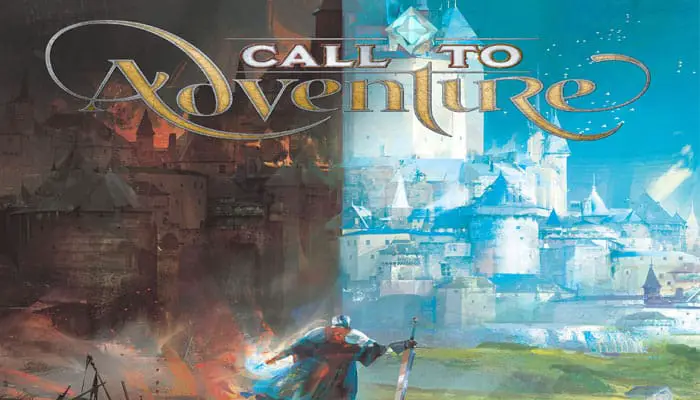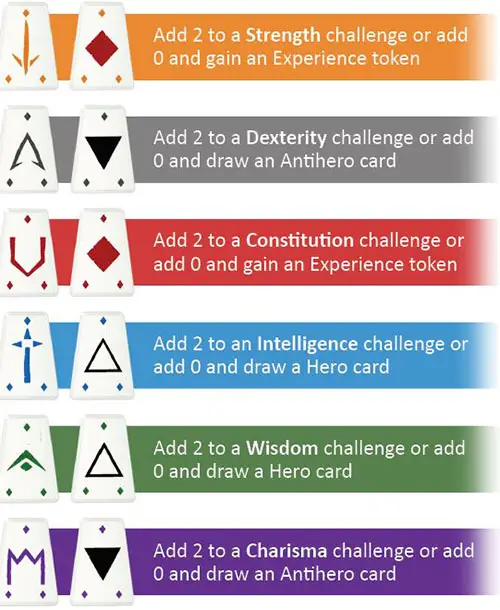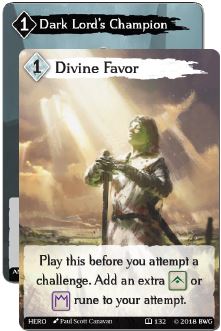

Components
- 45 Character Cards
- 91 Story Cards
- 44 Hero & Antihero Cards
- 12 Solo/Co-Op Cards
- 4 Player Boards
- 24 Runes
- 40 Experience Tokens
- Instructions
Object of the Game
In Call to Adventure, players face challenges and acquire traits over the course of three Acts. Along the way, each player's hero will gain Triumph points for victories, Tragedy points for following a darker path, and Experience tokens when they fail.
At the end of the third Act, the player with the highest Destiny score is the winner!
Triumph ( ) + Tragedy (
) + Tragedy ( ) + Experience (
) + Experience ( ) = Destiny
) = Destiny
Setup
Before the game begins, sort through all game components, shuffle the decks, and prepare the play space. During setup, each player begins creating a Character.
1. Deal the Cards

Deal each player six Character cards:
- 2 Origins (brown with bronze)
- 2 Motivations (blue with silver)
- 2 Destinies (red with gold)
Each player chooses one of each to keep, then removes the rest from the game.
If this is your first time playing, just deal each player one Character card of each type.
Deal every player one Hero card to form their starting hand. These should remain hidden. Finally, give each player three Experience tokens.
2. Reveal your Character
Your three-character cards form your hero's Story. Place your chosen Origin to the left (face-up), your Motivation in the middle (face-up), and your Destiny on the right (face-down, but you may look at your own at any time). Your Story will grow over the course of the game, and includes:
- How many Ability runes you have
- Triumph and Tragedy points you gain over the course of the game
- Any icons or special powers granted by your Character cards
Take a player board and place your character cards on it. On the left side of the player board is the Corruption tracker. This represents your character's morality and innocence.
During game setup, place your Hero marker on the third level of the tracker, indicating your Hero is neutral. Every time you gain a  (Corruption icon), move the tracker down one level. Every time you gain a
(Corruption icon), move the tracker down one level. Every time you gain a  (Virtue icon), move it up one level. Your position on the Corruption tracker dictates whether you can play
(Virtue icon), move it up one level. Your position on the Corruption tracker dictates whether you can play  or
or  cards, cast Dark runes, and affects your final score.
cards, cast Dark runes, and affects your final score.
Play Example: Story Tableau

When Suzanne is dealt her six Character cards, she chooses to keep Hunter as her Origin, Bound by Honor as her Motivation, and One With Nature as her hidden Destiny.
She places them on her playmat, sets her Corruption tracker to the starting level, and gets ready to play!
3. Prepare the Story Decks
In the center of the table, set up the three Story decks, the Hero Deck, and the Antihero Deck.
If this is your first time playing, we recommend removing the Allies and Adversaries from the story decks (as well as their related cards: Noble, Sole Survivor, Vow of Vengeance, Heir to the Throne, Master of Whispers, and Cruel Betrayal) until you get the hang of the game. Beside each deck, lay out a row of face-down cards.
- For a 2-3 player game, lay out four cards per Act (as shown below).
- For a 4-player game, lay out five cards per Act.
Once play is ready to begin, turn the Act I cards face-up.

Within easy reach of all the players, place the rune tray with the Core Runes, the Ability Runes, and the Dark Runes. The rune stones are shared by all players during the game.

Now you are ready and the first turn begins! The player who most recently finished reading a novel goes first.
Traits and Challenges
As you reveal Act I cards, you'll see two card types. Traits, like Secret Royalty and Adventurous, have just one "path" to follow. A trait can be gained if you meet its prerequisites.
Challenges, like The Academy and Lost in the Woods, have two paths. A challenge must be attempted by casting the runes and is gained if overcome.
Game Play
On your turn, you may gain a Trait or face a Challenge. You may also take other actions (see page 6), such as spending experience tokens and playing Hero or Antihero cards.
Gain a Trait
Traits define your character's personality, profession, and life experiences. A trait has only one "path".
To gain a trait card, you must simply meet any prerequisite listed on the card. When you gain a trait, place it under your current Storyline card. In general:
- Act I cards go under your Origin.
- Act II cards go under your Motivation.
- Act III cards go under your Destiny.
Leave the top of the trait card visible. Any Ability runes, Story Icons, or other rewards become a part of your Story.
Play Example: Gaining a Trait.
On her first turn, Suzanne spends  to gain Adventurous. Tucking it under her Origin card, she gains a Story Icon and a
to gain Adventurous. Tucking it under her Origin card, she gains a Story Icon and a  (Constitution) icon!
(Constitution) icon!

Attempt a Challenge
Challenges are the daring deeds your hero undertakes on the path to notoriety. When you attempt a challenge, you cast runes and hope for a good result. To face a challenge:
-
Assess the difficulty, indicated by the number on the left-hand side of the card.
-
Declare which path you're taking, indicated by the top or bottom of the card. If a path has a
 icon, the difficulty is increased by 1.
icon, the difficulty is increased by 1. -
Gather your runes.
- You can always cast the three core runes.
- Add one matching Ability rune for each relevant Ability icon you have in your story. Ability runes are relevant to a challenge if they are listed on the card under its difficulty on the left-hand side of the challenge card.
- If you spend Experience tokens (
 ), you may add Dark runes.
), you may add Dark runes.
-
Apply any card effects, such as Hero or Antihero cards.
-
Once you're ready, cast the runes!
-
If the result equals or exceeds the difficulty, you overcome the challenge. Gain the card, placing it under your current Character card with the top or bottom of the new card showing (depending on which path you took).
-
If you fail a challenge, discard it from the table and gain an Experience token (
 ).
).
Whenever you gain or discard a card from the table, replace it with another card from that Act deck. In the rare event that you have no valid options (e.g., four traits with prerequisites you do not meet), you may discard and replace one visible card without paying its Journey cost.
Reading the Runes
The runes give Call to Adventure the element of chance, but you can improve the odds by building your hero's Abilities. When you "cast the runes" you throw them on the table to see which sides land face-up.
Core Runes
You cast these three runes during every challenge.
 Add 1 to any challenge.
Add 1 to any challenge.
 Add 0.
Add 0.
 Add 0 and draw a Hero or Antihero card.
Add 0 and draw a Hero or Antihero card.
Dark Runes
Up to three times per turn (before you attempt a challenge), you may spend  to add a Dark rune to your casting.
to add a Dark rune to your casting.
 Add 2 to any challenge and move your Corruption track down by one.
Add 2 to any challenge and move your Corruption track down by one.
 Add 1 to any challenge.
Add 1 to any challenge.
Beware! As you gain Corruption, you lose the ability to play Hero cards. At  you lose 4 Triumph points and may no longer spend
you lose 4 Triumph points and may no longer spend  to cast Dark runes.
to cast Dark runes.
Ability Runes
Whenever you attempt a challenge, check your Character to see if you have any Rune icons relevant to that challenge. For each icon you have, you may cast one rune of that type (up to a maximum of three).
When you gain your third icon in an Ability, then and only then do you gain use of the Special rune marked with three dots (shown in the right-hand column below).


Other Actions
In addition to gaining a trait or facing a challenge, you may also take the following actions:
- Journey: Once per turn, you may spend
 to discard one card on the table and replace it with another card from the same deck. If a challenge with an Ally under it is discarded, the Ally is discarded as well.
to discard one card on the table and replace it with another card from the same deck. If a challenge with an Ally under it is discarded, the Ally is discarded as well. - Use another card effect.
- Play a Hero or Antihero card.
You may take as many of these actions as you have available.
Other Card Effects

In addition to Hero and Antihero cards, other cards have effects that you may activate during your turn. The effects and their costs are outlined in the card ability text.
- Many Origins provide a way to gain Experience Tokens.
- Many Motivations provide a way to spend Experience to gain an advantage.
Hero And Antihero Cards

Whenever you gain a  icon, or acquire a Path with
icon, or acquire a Path with  , draw a Hero card. When you gain a
, draw a Hero card. When you gain a  icon, or acquire a Path with
icon, or acquire a Path with  draw an Antihero card. When you get a result of
draw an Antihero card. When you get a result of  , you may choose which type to draw.
, you may choose which type to draw.

Your position on the Corruption track indicates whether you can play Hero cards, Antihero cards, or both. For example, if your position on the track has the  icon, you may play Hero cards, but not Antihero cards. You begin the game able to play both.
icon, you may play Hero cards, but not Antihero cards. You begin the game able to play both.
Most Hero and Antihero cards specify when they can be played. Otherwise, they can be played at any time. Their effects can even interrupt other players' actions, taking effect in the reverse of the order in which they're played.
After a Hero or Antihero card takes effect, place it face-up beside your character tableau. At end of game, add the Triumph or Tragedy value of any played cards to your score.
Ending your Turn
Once you are out of actions to take, play passes to the next player. During the "End of Turn", end any effects from Hero cards, Antihero cards, and other cards and draw a new card to replace any you claimed from the board that turn.
Ending an Act
When you have placed at least three trait or challenge cards under your current Act, you must end that Act. You may no longer gain traits or face challenges from that Act.
At the start of your turn, if you are the first player to have three cards from one Act, reveal the next row of cards.
All players may gain or face Story cards from any revealed Act, but you must still place three cards under your current Character card before proceeding to fill the next Character card.
Play Example: Ending Act I During Act I, Suzanne acquired a trait and overcame two challenges. She is ready to move on! In Act II, cards she gains will be placed under her Motivation card, Bound by Honor.
If Suzanne is the first player to complete Act I, she reveals four cards from Act II. Now any player may gain those cards.

End of the Game
When one player has gained three cards under their Destiny card, their final Act is closed. Each other player may take one final turn. Then, it's time for the "End of Game".
- To determine the winner, each player must reveal their Destiny card, then:
- Add up all Destiny points visible under your Character cards, adding Triumph (
 ) and Tragedy (
) and Tragedy ( ) points together.
) points together. - Add any points you have gained from Story icons.
- Add one point for every unspent Experience token (
 ) you have.
) you have. - Every Hero card you played is worth
 , regardless of your current Corruption position.
, regardless of your current Corruption position. - Every Antihero card you played is worth
 , regardless of your current Corruption position.
, regardless of your current Corruption position. - Then, add any Triumph or Tragedy points gained from your position on the Corruption track. (Corruption track points are not cumulative).
- Finally, gain any points from your Destiny card, based on the requirements you've met.
After applying all modifiers, the player with the highest Destiny score is the winner.
To conclude the game, each player tells their story! Describe how your hero's Character and Story cards fit together... how they emerged from humble Origins, followed their Motivation, and achieved their Destiny. Whether or not you won the game, you've hopefully created a memorable character!
Play Example: End Of Game
At the end of the game, Suzanne sees she has 17 Triumph and 2 Tragedy printed on her Story and Character cards. Her five matching Nature Story icons add another 8 Destiny.
Her Experience tokens add another 2 Destiny and her played Hero and Antihero cards are worth 2 Triumph and 1 Tragedy point respectively.
Without a Strength icon, she doesn't gain the 5 triumph from her Destiny, but she picks up an additional 5 Triumph for each of the Nature story icons.
Lastly, she gets 4 Tragedy for her final position on the Corruption track. Suzanne's final Destiny score is 41 ...a strong result! Time to tell the story of her hero!

Story Icons
As you build your hero's story, choosing certain paths can give you bonus points at the end of the game. The six Story Icons are Divinity, Justice, Nature, Arcana, Royalty, and Villainy:

Gaining more than one copy of a Story Icon will give you extra Destiny points at end of game. For each set you collect, add a bonus depending on the number of matching icons. All sets of Story Icons are scored in the same way, adding directly to your Destiny score at end of game:

Expanding The Game
Once you've gotten the hang of traits and challenges, add Allies and Adversaries to your game!
Future expansions will introduce new worlds and genres, but this core set also includes two new card types to enhance gameplay and storytelling:
Allies

Ally cards are shuffled into the Act I and Act II Story decks. When an Ally is revealed, the active player must choose a Challenge from that Act and tuck the Ally underneath it.
That challenge now has  . Allies can't be assigned to traits. A challenge may hold only one Ally. If there is no valid challenge when an Ally is revealed, discard the Ally.
. Allies can't be assigned to traits. A challenge may hold only one Ally. If there is no valid challenge when an Ally is revealed, discard the Ally.
When you overcome a challenge that holds an Ally, place the Ally face-up beside your Character tableau. Most Ally cards have powers that allow you to spend  or sacrifice the Ally (move it to the discard pile) to trigger beneficial effects.
or sacrifice the Ally (move it to the discard pile) to trigger beneficial effects.
Adversaries

Adversary cards are shuffled into the Act II and Act III decks. An Adversary is a special type of challenge with only one path: defeating that Adversary . Unlike ordinary challenges,
Adversary cards have powers that affect the game. These effects should be noted when the Adversary is revealed.
Otherwise, all rules for challenges apply to Adversaries. To face an Adversary on your turn, cast the relevant runes. If you succeed, tuck it under your Story card, keeping its rewards visible.
Continue Reading
